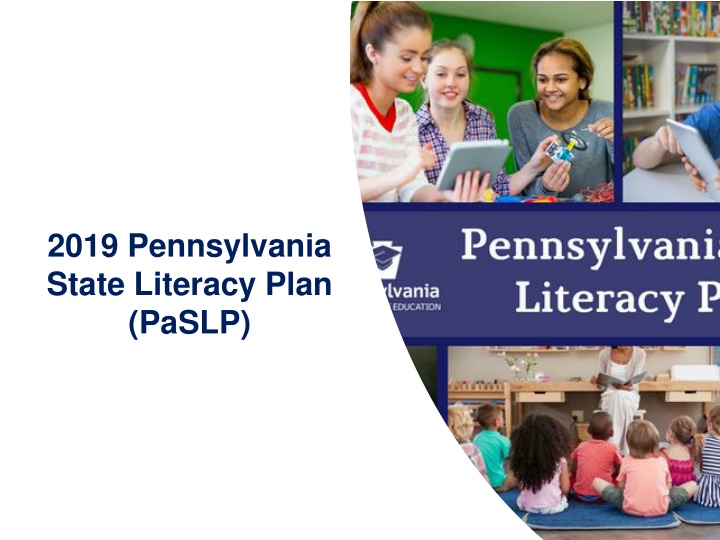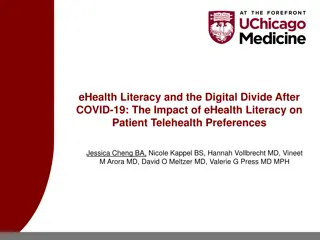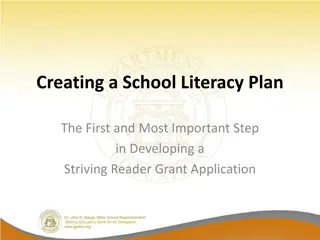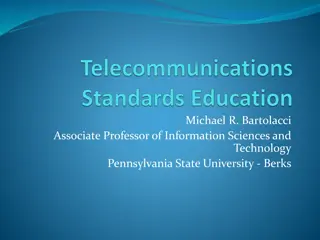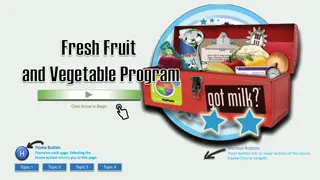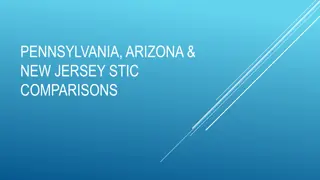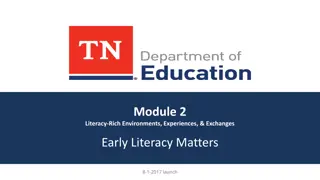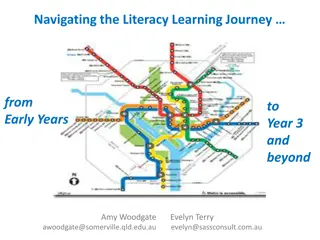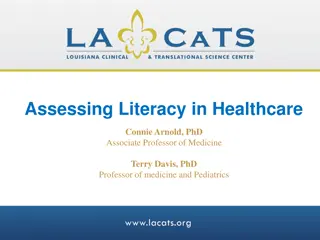Pennsylvania State Literacy Plan (PaSLP) Overview
Pennsylvania State Literacy Plan (PaSLP) aims to improve literacy learning outcomes by providing districts and charter schools with guidance and tools to develop local literacy plans, facilitate data-driven decision-making, and create 21st-century classrooms. The plan underscores key guiding principles such as literacy as a critical foundation, diversity, high expectations, evidence-based decision-making, and professional learning.
Download Presentation

Please find below an Image/Link to download the presentation.
The content on the website is provided AS IS for your information and personal use only. It may not be sold, licensed, or shared on other websites without obtaining consent from the author.If you encounter any issues during the download, it is possible that the publisher has removed the file from their server.
You are allowed to download the files provided on this website for personal or commercial use, subject to the condition that they are used lawfully. All files are the property of their respective owners.
The content on the website is provided AS IS for your information and personal use only. It may not be sold, licensed, or shared on other websites without obtaining consent from the author.
E N D
Presentation Transcript
2019 Pennsylvania State Literacy Plan (PaSLP)
Contact/ PDE Mission For more information on the PaSLP please visit PDE s website at www.education.pa.gov The mission of the Department of Education is to ensure that every learner has access to a world-class education system that academically prepares children and adults to succeed as productive citizens. Further, the Department seeks to establish a culture that is committed to improving opportunities throughout the commonwealth by ensuring that technical support, resources, and optimal learning environments are available for all students, whether children or adults. 2019 2
History of Pennsylvania Literacy 1977 - A Comprehensive Reading Communication Arts Plan (written by Dr. Morton Botel) 1998 - The Pennsylvania Framework for Reading, Writing, and Talking Across the Curriculum (written by Dr. Susan Lytle & Dr. Morton Botel) 2000 - The PA Literacy Framework (Dr. Jean Winsand, chairman) 2012 - The Comprehensive Literacy Plan (Dr. Rita Bean, chairman) 2019 - Pennsylvania State Literacy Plan (Dr. Rita Bean, chairman) 2019 3
Purpose of PaSLP The Pennsylvania State Literacy Plan (PaSLP) provides: Districts and charter schools with the guidance and tools needed to develop and implement a local literacy plan; Leadership with information to facilitate the analysis of local literacy needs and to develop curriculum addressing the needs; and Leadership with information to develop professional learning experiences for teachers. 2019 4
Goals Improve literacy learning outcomes Create a culture of data-informed decision making Create 21st century classrooms and schools 2019 5
Visual Representation 6 2019
Guiding Principles 1. Literacy as a Critical Foundation for all Learning 2. Diversity 3. High Expectations 4. Evidence-Based Decision Making 5. Professional Learning 2019 7
Guiding Principle 1 Literacy as a Critical Foundation for All Learning Being fully literate in the 21st century requires that students: Read, write, and communicate at high levels; Construct meaning from and across multiple sources; and Communicate ideas orally and in writing. 2019 8
Guiding Principle 2 Diversity Acknowledge, value, and respect diversity in our schools and classrooms. Provide educational experiences that enable students to learn about their own culture as well as the culture of others. Value and acknowledge diversity in our curriculum and instructional practices. 2019 9
Guiding Principle 3 High Expectations Belief that all students can gain literacy skills that prepare them to be future ready; Instruction that addresses the full range of learners and differentiated to meet each student s needs; and Well-integrated system connecting general, compensatory, gifted, and special education. 2019 10
Guiding Principle 4 Evidence-based Decision Making Literacy programs, practices, and policies must be: Evidence-based, Grounded in reliable and valid research results, and Informed by experiential and contextual evidence (resources for educators). 2019 11
Guiding Principle 5 Professional Learning Teach effectively in the schools of the 21st century. Understand the mechanisms of reading acquisitions, and Address the diverse needs of students in the 21st century Ongoing, job-embedded learning opportunities promoting lifelong learning and reflective teaching. Understand reading psychology and development, Understand the structure of the English language, Apply best practices in all aspects of reading instruction, and Use validated, reliable, efficient assessments to inform classroom teaching 2019 12
Essential Elements 1. Standards 2. Oral Language and Academic Discourse 3. Assessment 4. 21st Century Classrooms 5. Differentiated Instruction 6. Disciplinary Literacy 2019 13
Essential Element 1 Standards Literacy programs (birth-grade 12): - Well-articulated, coherent set of goals based on PDE standards; - Articulation between all levels, especially at important transition points; - Reciprocal relationship among the language arts (reading, writing, speaking, and listening); and - Meaningful integration of literacy experiences. 2019 14
Essential Element 2 Oral Language and Academic Discourse Oral language is the foundation for learning and for literacy development. Speaking and listening are tools of communication that become the basis for the written word. 2019 15
Essential Element 3 Assessment Assessment systems should address the dual purposes of assessment (i.e., accountability and informed decision-making). An effective assessment plan requires: - inclusion of technically adequate information, - multiple measures, and - opportunities for educators to learn how to administer, analyze, interpret, and apply data results to inform instructional practices and improve student learning. 2019 16
Essential Element 4 21st Century Classrooms Classrooms must offer students opportunities to develop real- world problem-solving skills that enable them to: - think critically and creatively, - work collaboratively with others, and - analyze, interpret, and synthesize information. 2019 17
Essential Element 5 Differentiated Instruction Proponents of differentiation purport that its principles and guidelines are grounded in years of educational research and have roots in theories of learning. Differentiated instruction is an awareness of and active response to students various needs. Differentiation often requires systemic curriculum adaptations which transcend individual classrooms and require alignment of these practices across classrooms. 2019 18
Essential Element 6 Disciplinary Literacy Provides students with supported experiences and opportunities to read, write, talk, and think deeply in service of content learning. Allows students to experience deep disciplinary literacy as a means of learning content. 2019 19
Implementing the Plan Section A Section A Specific action areas and recommendations Action Area #1: Standards and Goals PDE provides: PA Learning Standards from birth to grade 12; and Standards Aligned System (SAS) that integrates standards with instruction and assessment available on website. Recommendations to districts and charter schools: Align curriculum to PA Early Learning and PA Core Standards; Increase rigor in meeting PA Core Standards with commitment to high expectations for all students; and Utilize SAS to provide professional learning and technical assistance to increase knowledge and use of available resources, including curriculum mapping tool, curriculum frameworks, assessment tools, instructional resources, and transition documents. 2019 20
Implementing the Plan Section B Section B - Summary of each guiding principle - Guidance for the various entities that support literacy education Guiding Principle 1 Literacy as a Critical Foundation for All Learning - Regional Support Agencies: Promote professional learning activities that deepen educators understanding of the Pennsylvania State Literacy Plan, PA Core Standards, and available resources at the state level. - Districts and Charter Schools: Develop literacy programs based on a needs assessment process; programs are coherent, aligned vertically and horizontally, and shared by all. - Early Learning Providers: Seek opportunities to work with schools and families or caregivers to promote early language and literacy learning. 2019 21
Implementing the Plan Section C Section C - Resources for developing, implementing, or evaluating a literacy plan Pennsylvania State Literacy Plan Needs Assessment - www.education.pa.gov - www.pdesas.org. Complete PA Literacy Needs Assessment - Partial PA Literacy Needs Assessment Step 1 Step 2 Step 3 Step 4 Step 5 - 2019 22
Appendixes Appendix A Building Upon Keystones to Opportunity (2011-2019) Appendix B Professional Learning Opportunities Appendix C Using Student Outcomes Data for Decision Making 2019 23
Resources - SAS Standards Aligned System (SAS) Standards Assessment Curriculum Framework Instruction Materials and Resources Safe and Supportive Schools 2019 24
Resources - PaSLP o PaSLP o 2019 Pennsylvania State Literacy Plan o Pennsylvania State Literacy Needs Assessment o PA Literacy Plan Template o PA Learning Paths o PaSLP Toolkit o PaSLP Visual Representation o PaSLP Guiding Principles o PaSLP Essential Elements o PaSLP Guiding Questions o PaSLP Reading Focus of Instruction o PaSLP Writing Focus of Instruction o PaSLP Language Focus of Instruction o PaSLP Speaking & Listening Focus of Instruction o PaSLP Bookmarks o PaSLP Poster 2019 25
Contact Information For more information on ELA updates please visit PDE s website at www.education.pa.gov. Should you have any questions regarding this information, please contact: Rebekah Baum-Leaman, Ed.D. rbaumleama@pa.gov or RA-EDPASLP@pa.gov. RebekahBaum-Leaman, Ed.D. | ELA Content and Assessment Advisor Division of Instructional Quality Bureau of Curriculum, Assessment and Instruction Phone: 717.783.6538 rbaumleama@pa.gov | www.education.pa.gov 2019 26
